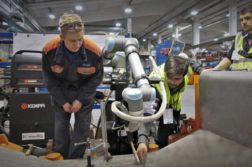Universal Robots ambassador in Finland
+358 44 590 3122
anlu@universal-robots.com
Collaborative robots were introduced in 2008 to the markets when Universal Robots unveiled their first robot, the legendary UR5, that was able to perform tasks without safety fencing next to an employee. Why was it so important to create such a robot which is fundamentally designed to work safely with and not something to separate from people? Customer behavior is the most fundamental thing that drove three university guys into designing something totally new to industry, e.g Tesla designed a totally new species of cars.
Change in buying behavior resulted in smaller batches and shorter lead times especially for the SME’s providing most of the commodities for any industrial or consumer products. The SME’s couldn’t afford to invest in heavy robotics solutions without huge risk involved, were labor intense and inflexible in many Western countries.
Cobots are an easy way to automate anything done by people and by hand. This allows people to have their focus on more productive tasks where a person is more productive making right decision compared to a robot. This might resolve the challenge of not being able employ or train enough people to meet the production targets in volume.
All robots, collaborative and industrial, still need to be taught how to do things and that is the reason cobots are a great choice for doing the tedious, uncomfortable and unergonomic tasks done by hand now. This will help the employers to have better working environment, happy employees as well having more business at their reach due to more cost-effective production and more capacity from the resources.
In some cases, the idea can become as a solution in less than two weeks.
Safety first
There is no right and wrong way to solve safety as long the adequate safety measures are in place and the safety of the employee is taken into consideration when employing a cobot as your co-worker.
The technology behind the collaborative robots differs per manufacturers:
- Some have the safety features built-in
- Some add safety equipment to a traditional industrial robot
The safety levels also differ from manufacturer to another and of course every company have their way of implementing safety to their production.
It is the employee who is going to program the robot, feed the material, make the decision for the cobots and in that sense taking care of the cobot co-worker. With the help of these skilled people the production runs as it should and is designed to do. The persons involved in the production should be empowered when designing a solid and safe working environment.
Advantages
Flexibility is one key features in cobots for many companies, having the freedom to re-deploy the robot in several locations, even during the day, is something that is hard to do with industrial robots.
Cobots bring robots closer to people than ever before, they are easy to approach, I was in an event last week where a 7-year old robot enthusiast programmed a robot to do pick-and-place application in less than 15min. I would say that was pretty easy programming.
Today, cobots are only a small part of the robotics market but with a bright future ahead of them, the cobot sector is expected to grow in a constant pace and far faster than the industrial robots. Cobots are expected to reach up to 60% market growth per year according to International Federation of Robotics 2018.
From connected machines to human-machine interaction
Numbers of growth also mean that countries like Finland need to able to implement the technology more and more every year in order to tackle the technology gap. That can only happen if our educational programs and foundations are fit for the future talent needs. Industry 4.0 with it’s connected machine network is here already.
I’m personally already implementing Industry 5.0, the interaction between human and the machine. We can see the results of cobot forerunners in the recent media, e.g Agco Power at Nokia stating that they will employ cobots instead of robots at their new factory in the future. I’m looking forward to seeing how Industry 5.0 will evolve in Finland. The technology is already available but are we mature enough to accept it as a solution?


